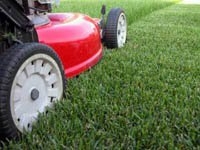
|
Lawn Tips - Mowing
Proper mowing is essential for a good looking lawn. Or, to put it another way, improper mowing causes more lawn problems than anything else. There are two common errors: The lawn isn't mowed often enough. Or, the lawn is mowed too short. These errors reduce the vigor of your grass and cause poor root development. When this happens, you're more likely to have problems with weeds, insects, diseases and stress injuries such as drought.
To keep your lawn at its best, don't remove more that 1/3 of the grass blade at one time.
When to cut your grass:
There is no fixed schedule for mowing. Most people think that cutting once a week is sufficient all season long. Instead, let the growth rate of the grass be your guide.
In early spring, the grass may need cutting more than once a week. Then, as weather conditions slow things down, once every week or ten days may be adequate. The secret is not to cut off more than 1/3 of the grass blade in one mowing.
If, for some reason, your grass has grown very high before you have a chance to cut it, don't cut it down to normal height in one mowing. That upsets the delicate balance between the roots and the leaf area. Reset your mower instead to the highest cutting level. Then after three or four days, cut it to normal height.
|
Select the proper mowing height for your lawn.
Bluegrass - 2.5 to 3 inches
Bluegrass Fine Fescue - 2.5 to 3 inches
Ryegrass - 2.5 to 3 inches
Tall Fescue - 3 to 3.5 inches
|

Return to Main Tips Page
|
|
|
|
Other factors you'll want to be aware of...
Sharp blades - A sharp mower will cut the grass blades off cleanly, rather than shredding them. Shredding will cause your grass to discolor at the tips. Or, you may discover disease organisms have invaded your grass through the shredded wounds. Rotary mowers, which most home owners use, should be sharpened several times during the season.
Damaged grass - Lawns recovering from drought, insect damage, and disease will do better if you raise the mower height a notch or two until the grass has fully recovered.
Clippings should not be removed for two mowings following the application of fertilizer and other materials to your lawn. If these clippings are removed, part of the applied materials will also be removed and the maximum benefits will not be achieved. Research has shown that continuous return of clippings recycles nutrients and benefits your lawn. Contrary to popular opinion, returning clippings to your lawn does not significantly contribute to thatch buildup. However, clippings should be removed if they are excessive, as they will smother your lawn. This an indication that you need to increase mowing frequency, as you are probably removing more than 1/3 of the grass blade.
Cutting wet grass can cause problems - Wet clippings tend to bunch together and can smother your lawn, causing brown areas. Do not mow your lawn when the grass is wilted.
Cutting wilted grass, particularly during the hot part of the day, may cause severe damage to your lawn.
|
|
|

© 2014 Earl's Lawn Service. All Rights Reserved.
|